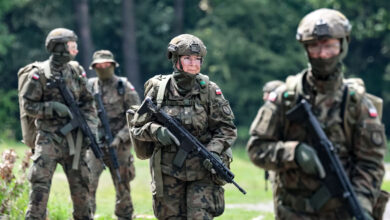
Guro puts in 60 to 70-hour weeks, half her time spent on football and the other half at her job, but that’s just the way it is if you’re a woman football player in Norway.
The Scandinavian country made headlines when it announced in October 2017 that its national women’s team would earn the same as their male counterparts, in a groundbreaking move.
But equal pay for other professional football players remains a pipe dream, even in this egalitarian nation.
While top division wages in Norway come nowhere near the astronomical sums earned by the Messis and Ronaldos of the men’s top leagues, men still earn way more than women, who typically make just a few hundred euros a month even though they are signed to professional contracts.
To make ends meet, most women players hold down jobs off the pitch, or study and live off student loans.
“You really have to love what you do, because otherwise you don’t have the heart to do it,” says Guro Bergsvand, a defender for the Stabaek club who by day is head of administration for an IT company.
Her daily routine is jam-packed and disciplined.
Everyday, she leaves the house at 6:00 am for a workout. Then she has a “normal” workday at the office, and rounds it all off with football practice. She usually returns home around 7:00 pm or 8:00 pm.
“It’s not easy. Your employer also has to understand you, they have to understand that women play football. Because not everyone does,” she says.
Underfunded
Norway is one of the leading women’s football nations, winning the World Cup in 1995, two European Championships in 1987 and 1993, and an Olympic gold medal in 2000.
It is also home to the first women’s Ballon d’Or winner, Ada Hegerberg, a role model for aspiring young talents — and who has complained about the lack of respect the Norwegian Football Federation has shown women’s football and has therefore boycotted the national team for two years.
For that reason, Hegerberg is absent from the World Cup in France where Norway play their first match against the host nation on Wednesday.
But the women’s professional league remains sorely underfunded.
Almost eight of 10 players in the women’s Toppserie earn less than 100,000 kroner (10,200 euros, $11,590) a year, according to a report by newspaper VG. And 13.6 percent of them don’t make a cent.
In 2017, the club Avaldsnes had to resort to online crowdfunding to make ends meet to be able to travel to Montenegro for the Champions League qualifiers.
The same year, the average income for a single player at Rosenborg, which won the men’s top division, was higher than that of all of the women combined who played for LSK, which won the women’s top division.
Even at Lillestrom, the lowest-ranking team in the men’s division, the average player’s wage was more than 3.5 times what LSK players earned that year.
Progress
Because of the strain of having a full-time occupation in addition to football, many young talents burn out quickly and give up the game too early.
Others go abroad, like the Hegerberg sisters — Ada plays for European champion Lyon and Andrine for Paris Saint-Germain, or Caroline Graham Hansen who just left Wolfsburg for Barcelona.
And some quit their studies, at the risk of putting their future careers in jeopardy.
“It was too difficult. I tried for a long time to find a balance between my studies and full-time football,” says Kristine Leine, a defender with Roa IL who has taken a break from nursing school.
“It worked for a couple of years but I noticed that I wasn’t progressing enough in football. I was often too tired at practice to give it my all,” she says.
The 2017 deal to give Norway’s men’s and women’s national team players the same salaries — a first in the world — is seen as a first step in the right direction.
Sponsors are also ponying up now, giving clubs more money so they can for instance organize a weekly “pro day” dedicated entirely to girls’ training.
But there’s more to it than just pay inequality, says Guro Bergsvand, who regularly gets annoyed over other things.
For example, there’s no physiotherapist present at the women’s practices, though there is one at the boy’s youth academy for 12 and 13-year-olds.
And PowerPoint presentations made for the boys’ teams that no one bothers to modify for the girls’ teams.
“These differences in how we’re treated, they hurt.”
Image: AFP/File / Attila KISBENEDEK Norwegian Ada Hegerberg is the world’s top women’s player but is boycotting the World Cup complaining about the lack of respect the Norwegian Football Federation has shown women’s football




